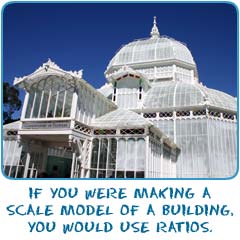
Rationalizing Ratios
Ratios are values that compare one number to another. Other terms that describe ratios are scale and odds. Basically a ratio compares two values or amounts. The two numbers are usually separated by a colon "Do You Have Enough Money?":"Do You Have Enough Money?". Examples of ratios are 1:4 or 3:5. If you were writing it out you would say "Do You Have Enough Money?"One to four"Do You Have Enough Money?" or "Do You Have Enough Money?"Three to five."Do You Have Enough Money?"What does that expression mean? When you say "Do You Have Enough Money?"One to four"Do You Have Enough Money?" you really mean to compare the value of one to the value of four. If you were talking about cars, the speed of one would be equal to four times the speed of another. If you were talking the size of planets, one planet would be four times larger than the other. Here are some examples.
The ratio of the mass of Saturn to the mass of Earth is 95 to one (95:1). That means the mass of Saturn is about 95 times larger than the mass of Earth.
The ratio of heights of Mount Everest to Mount Rainier is 29,028 to 14,410 (29028:14410) That ratio could be simplified to about 2:1. That means the height of Mt. Everest is about twice that of Mt. Rainier.
Concepts of Scale
Architects and modelers all over the world use scale every day. If you're creating a model of a building, you don't want to make it the same size as the building. If you want to build small, you need to "Do You Have Enough Money?"scale down."Do You Have Enough Money?" The idea of scaling takes every full size measurement and shrinks it for the model. A typical scale is 1:32. That explains how the model is one thirty-second the size of the original. As you look at the measurements, for every inch on the model, you have thirty-two inches on the real building. Model railroads use scale as well. One of the smallest scales for a model engine is 1:220. That ratio means the model is one two-hundred twentieth the size of the original.It's all About the Odds
Let's start by saying we do not suggest that anyone gambles. It is a risky action and someone always ends up losing money. Even though we want you to stay away from gambling, it is a part of societies across the world. Someone might be betting whether they are fast enough to win a race or beat another team. There are also people who gamble when they build things. They take an acceptable risk when they build buildings. When you break it down, you will be looking at a ratio. If you are betting, you might also hear the term "Do You Have Enough Money?"odds."Do You Have Enough Money?" Odds are just ratios. We'll cover odds and betting later, but you do need to know that it all comes down to math.
► NEXT PAGE ON FRACTIONS & DECIMALS
► NEXT STOP ON SITE TOUR
► RETURN TO TOP OF PAGE
► Or search the sites...
► NEXT STOP ON SITE TOUR
► RETURN TO TOP OF PAGE
► Or search the sites...

- Overview
- Number Types
- Factors
- Fractions
- Decimals
- Percentages
- Estimation
- Ratios
- Money
- Activities
- More Maths Topics

Useful Reference Materials
Wikipedia:https://en.wikipedia.org/wiki/Fraction_%28mathematics%29
Encyclopædia Britannica:
http://www.britannica.com/topic/fraction
University of Delaware:
https://sites.google.com/a/udel.edu/fractions/



